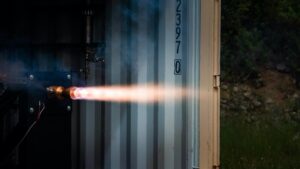Stoke raises seed round to work on fully reusable rockets
By Jeff Foust

WASHINGTON — A startup founded by a group of former Blue Origin and SpaceX employees has raised a seed round of funding to support their effort to make a fully reusable launch vehicle.
Stoke Space Technologies announced Feb. 25 it raised $9.1 million in seed funding in a round led by venture funds NFX and MaC Ventures. Several others funds and individuals participated in the round, including Y Combinator; Seven Seven Six, a new fund established by Reddit co-founder Alexis Ohanian; and Liquid2, a fund that previously invested in satellite manufacturer Astranis.
Stoke, based in the Seattle suburb of Renton, Washington, has no shortage of ambition. Its goal, the company said in its announcement of the funding round, is “100% reusable rockets designed to fly daily” that it claims could reduce the cost of space access by a factor of 20.
“We’re still in ‘reusability 1.0’ and it’s time to go to ‘reusability 2.0,’” Andy Lapsa, co-founder and chief executive of Stoke, said in an interview, citing efforts by SpaceX to recover and reuse the first stage of its Falcon 9 launch vehicle. “In reusability 1.0, these are things that can be reused but they’re not necessarily things that are operationally efficient to reuse. Reusability 2.0 is the next step, where we’re now focused on operations and quick turnaround.”
In that vision, both the rocket’s upper and lower stages would be reusable and able to be turned around quickly for another launch. “If it’s designed to fly daily and be turned around quickly, there’s a whole lot of things you are not doing,” he said, such as tearing the vehicle down between flights and doing detailed inspections. Such a vehicle would instead rely on automated checks with a minimum of labor and maintenance.
The nine-person company is currently focused on the vehicle’s upper stage. While SpaceX has demonstrated the ability to routinely reuse first stages and other companies, like Blue Origin, are following a similar path, second stages are more challenging because of their higher velocities and energies. SpaceX for a time pursued an effort to make the Falcon 9 second stage reusable, but eventually abandoned that. “The second stage is the last big domino to fall in reusable rockets,” he said.
Lapsa, who worked on engine development for a decade at Blue Origin before founding Stoke, said the company is focused on the engine for that second stage, recently conducting tests of the engine’s injector. “We will continue to be building on second stage vehicle and engine systems” with the seed funding, he said. “We will not have them all integrated together at the end of the seed, but that’s where our focus is, to build the foundational building blocks for the second stage systems.”
He revealed few technical details about their proposed vehicle and its enabling technologies, or the timeline for its development. He said the vehicle will be sized based on market demand in order to hit its desired launch cadence.
Asked how the company’s concept for a reusable second stage might differ from traditional designs, he said a conventional design isn’t well suited for recovery and reuse. “You should expect that the technical solution is somewhat different from a conventional stage, and it has to be,” he said. “That’s what we’ve been studying over the last year.”
The company has received a pair of Small Business Innovation Research (SBIR) awards in 2020 that provide hints about its plans. One, a $225,000 SBIR from the National Science Foundation, is devoted to an “integrated propulsion solution to enable reusable upper stages.” The project, an abstract for the SBIR states, “proposes to develop new technology enabling space launch vehicles to re-enter the atmosphere and land propulsively at a target destination for reuse.” That study looked at “a new technical solution combining fundamental vehicle performance with system-level efficiencies to enable reusable second-stage vehicle designs.”
The other SBIR, from NASA and valued at $125,000, studied a “novel rocket engine configuration” that could be used on upper stages as well as planetary landers. “The engine uses a novel rocket nozzle geometry that has not been previously considered,” the SBIR abstract states. “When strategically integrated into the vehicle base, the engine nozzle serves as an actively cooled metallic heat shield during atmospheric entry maneuvers.”
Lapsa said Stoke’s investors are sold on the company’s vision. “All of them are very excited about the technology, very excited about our team,” he said. “They have either been watching space for a while, waiting to place a bet, or excited to get into space.”
“If space is the next frontier, we need more efficient transit to and from space,” Morgan Beller, general partner at NFX, said in the statement about the funding round. “Stoke plans to significantly improve the cost and availability constraints of the existing market, which will increase the innovation (and demand!) around what’s possible.”
February 25, 2021 at 10:35PM
via SpaceNews read more...

Post a Comment